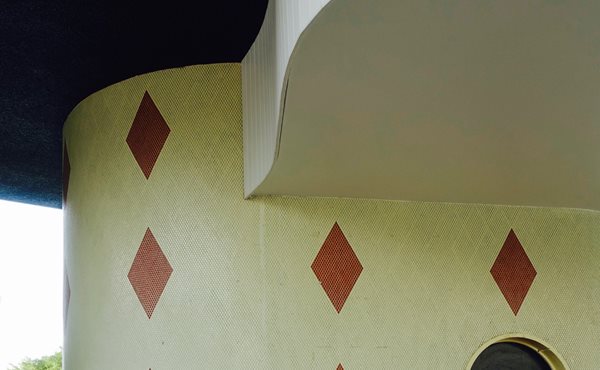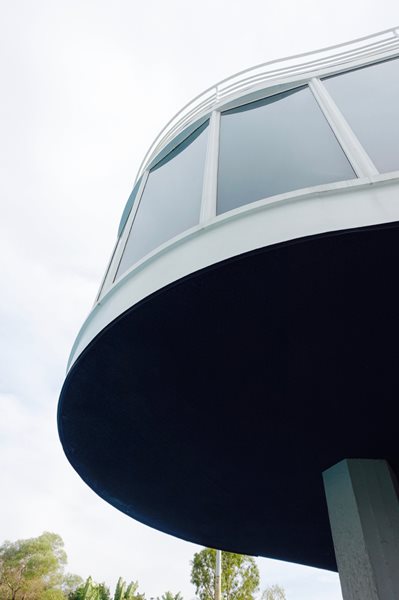Australia’s relationship with the public swimming pool runs deep. It also takes on many different faces as the climate and geography of the towns they inhabit shift. One milestone in the expression of this national pastime is Brisbane’s Centenary Pools.
The complex is nestled into the southern slope of Brisbane’s Victoria park and is known for two objects over the scattered of pools: a curvilinear kiosk and restaurant (now gym) and a slender concrete diving tower.

The grandstand and amenities block, substantial elements of the design, are tucked under the street level, only the raked roof planes are visible through the bordering native landscaping, adding to the drama.
Built in 1959, the Centenary Swimming Pools not only marked the birth of modernist Brisbane, but a new phase in Australian aquatics. At the 1956 Melbourne Olympics, Australia had won 13 gold medals, eight of which were by swimmers – Australia made it out of the kiddy pool.

Accordingly, Brisbane City Council would build seven public swimming pools, the feature being the Centenary Pools designed by Council architect James Birrell. It was the only Olympic standard complex developed, on par with those built in Melbourne and Canberra, and would remain the principal pool for competitive swimming in Brisbane until the 1980s.
James Birrell completed a number of significant works in Queensland as staff architect for Brisbane City Council, later as University of Queensland staff architect, and in private practice from 1966. These projects, including Union College, Wickham Terrace Carpark, and Toowong Municipal Library, earned him the RAIA Gold Medal in 2005.

The Centenary Pools would appear to reside stylistically outside his oeuvre, but his design principles remained constant. In an interview 2012, Birrell expressed confusion that some of his work, namely Union College, was labelled brutalist; “I didn’t consider it brutal at all… it was something that just ran along with your general philosophies”.
Birrell’s principles were fluid, metaphorically and literally – starting with a focus on site responsiveness within a relatively dry Brisbane parkland context, the new and varied requirements of the public pool and in this project he had a focus on the festive nature of the pool as public space. It is playful, but still pragmatic.
Centenary Pools may seem to belong to Brazilian modernism, abstract geometric forms suspended in space through a free form use of concrete. But it’s pure Brissie, not so far from the Go-Betweens love of the playful and serious at the same time.

So what’s so playful about the place? Starting from the top, an organic curved structure spreads itself out over the main pool, cantilevering off board finish concrete pillars. The undulating panoramic glass curtain of this space once hosted Brisbane’s restauranteurs, it now hosts body builders and cardio cougars – as much a sign of the times as the structure’s form was in the 1960s.
The curves are cut by a series of opposing pillars that host the diving boards, inclined over the second pool, another response to the “festive air” Birrell envisaged.
A further interruption was the circular wading pool that crept under the curved upper level. Sadly, additions have compromised the drama of this platform space. It initially sat in isolation above the pool level, like an ice cube melting in the Brisbane heat.
Another shift in level occurs below the pool plane, as the site slopes down to Victoria park itself. An underwater viewing area to the main and diving pool may be accessed below podium level, giving professional swimming instructors the edge.
The finishes themselves are as free formed as complex’s layout. The wading pool is tiled in organic patterns, blue and grey terrazzo partitions differentiate the female and male changerooms respectively, brickwork is left unstruck, and glazed tiles encrusted with diamond patterns run up the core of the central kiosk tower.

It’s difficult to sum up what makes an Australian pool. It’s equally difficult to characterise how James Birrell operated across such a variety of buildings. The Centenary Pools are just one exceptional chapter of both stories; a playful pool for serious swimming.
In 1996, the Centenary Pool Complex was added to the Queensland Heritage Register. James Birrell died two months ago in September 2019.
Researched and written by Jackson Birrell, an AAA volunteer, photos by Megan Alinama, edited by Tone Wheeler for the Australian Architecture Association. For more information on the AAA and its activities to promote architecture, go to https://www.architecture.org.au/

